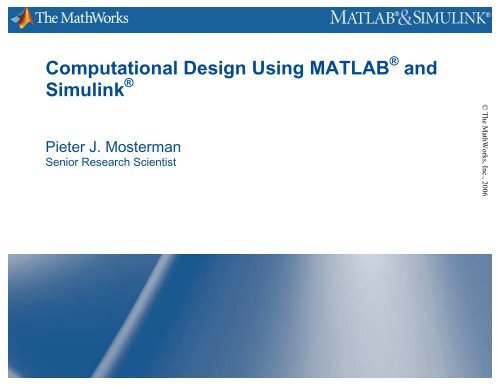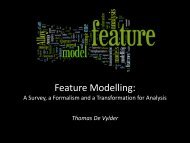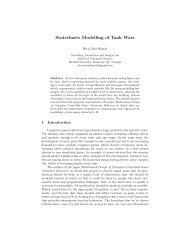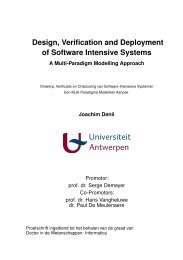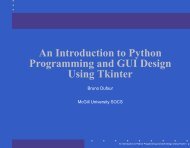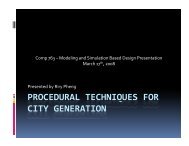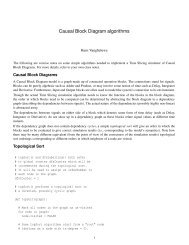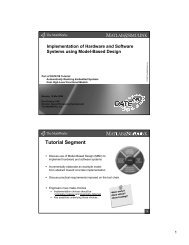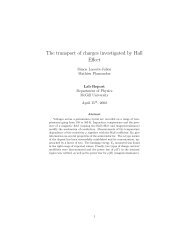Computational Design Using MATLAB and Simulink - MSDL
Computational Design Using MATLAB and Simulink - MSDL
Computational Design Using MATLAB and Simulink - MSDL
You also want an ePaper? Increase the reach of your titles
YUMPU automatically turns print PDFs into web optimized ePapers that Google loves.
<strong>Computational</strong> <strong>Design</strong> <strong>Using</strong> <strong>MATLAB</strong> ® <strong>and</strong><br />
<strong>Simulink</strong> ®<br />
Pieter J. Mosterman<br />
Senior Research Scientist<br />
© The MathWorks, Inc., 2006
Introduction — Model-Based <strong>Design</strong><br />
<strong>Computational</strong> models are key!
Agenda<br />
<strong>Computational</strong> design example (~5 min.)<br />
– Engine calibration<br />
Accelerated simulation (~5 min.)<br />
– The Embedded <strong>MATLAB</strong> <strong>Simulink</strong> block<br />
Distributed Simulation (~10 min.)<br />
– Distributed <strong>MATLAB</strong><br />
Conclusions (~5 min.)
Engine Calibration<br />
Derive extensive calibration tables for control<br />
Determine experiments <strong>and</strong> their density<br />
Obtain optimal representation<br />
Typically towards the end of the design process<br />
Desire to implement as a concurrent activity<br />
Apply computational models!
Model-Based Engine Calibration
Accelerated Simulation<br />
Compiled simulation model<br />
M code in <strong>Simulink</strong>?<br />
Embedded <strong>MATLAB</strong> block!<br />
Asteroids in <strong>Simulink</strong><br />
% 1. Compute Phi, Q, <strong>and</strong> R<br />
Phi = [1 deltat 0 0; 0 1 0 0 ; 0 0 1 deltat; 0<br />
Q = diag([0 .005 0 .005]);<br />
R = diag([300^2 0.001^2]);<br />
% 2. Propagate the covariance matrix:<br />
P = Phi*P*Phi' + Q;<br />
% 3. Propagate the track estimate:<br />
xhat = Phi*xhat;<br />
% 4 a). Compute observation estimates:<br />
Rangehat = sqrt(xhat(1)^2+xhat(3)^2);<br />
Bearinghat = atan2(xhat(3),xhat(1));<br />
% 4 b). Compute observation vector y <strong>and</strong> linea<br />
yhat = [Rangehat;<br />
Bearinghat];<br />
M = [ cos(Bearinghat) 0 sin(Bearingha<br />
-sin(Bearinghat)/Rangehat 0 cos(Bearingha<br />
% 4 c). Compute residual (Estimation Error)<br />
residual = meas - yhat;<br />
% 5. Compute Kalman Gain:<br />
W = P*M'*inv(M*P*M'+ R);<br />
% 6. Update estimate
Distributed Simulation<br />
The calibration process is ‘embarrassingly<br />
parallel’<br />
Large number of independent experiments<br />
Distributed approach!<br />
Convenient <strong>and</strong> efficient implementation<br />
Powerful language constructs desired<br />
– Dynamic typing<br />
– …
Conventional High Performance<br />
Computing Workflow<br />
Without the distributed computing tools
Conventional High Performance<br />
Computing Workflow<br />
Without the distributed computing tools
High Productivity Computing Workflow<br />
<strong>Using</strong> distributed computing tools
Enabling the High Productivity Workflow<br />
Availability of hardware with super computing<br />
power from our desktop<br />
Multi-core<br />
Multi-processor<br />
Cluster<br />
Grid<br />
Ability to take advantage of this for highly<br />
productive computational design
How did The MathWorks do it?<br />
Pluggable scheduler
How did The MathWorks do it?<br />
Pluggable scheduler
Benefit of Pluggable Scheduler<br />
Integration of distributed computing tools with<br />
existing cluster environment of customer<br />
Heterogeneous clusters<br />
<strong>MATLAB</strong> <strong>and</strong> other applications run on the<br />
same cluster<br />
Increased throughput<br />
Reduced cost of ownership<br />
Exploit unique capabilities of schedulers<br />
Advanced scheduling<br />
Batch workflow support<br />
Utilization <strong>and</strong> performance increase<br />
Scalability, reliability, <strong>and</strong> security
Object-oriented <strong>and</strong> Functional Interface
Distributed Simulation <strong>and</strong> GT-Power
Resource Management Trends<br />
Microsoft Cluster Computing Server
Other Applications — EIM Group
Why no parallel <strong>MATLAB</strong> before?<br />
Cleve’s Corner in 1995<br />
It did not make business sense at the time…
Market Trend<br />
The 10 GFLOP Personal Computer!
Recap<br />
High productivity computing
Conclusions<br />
Hardware<br />
Less expensive<br />
Networked<br />
Software infrastructure<br />
Operating system support<br />
Scheduling software<br />
Software applications<br />
Inherent support for distributed computing<br />
Think matrices not messages!


